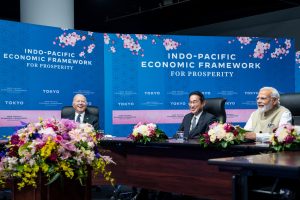With the U.S. debt ceiling deal dominating headlines, a less eye-catching development might easily be overlooked. A year after it was first announced, the Indo-Pacific Economic Framework for Prosperity (IPEF) finally produced its first deliverable at a ministerial meeting on May 27. The 14 participating countries agreed to a deal to enhance supply chains by sharing information and collaborating during a crisis, making it the world’s first multilateral supply chain deal.
Still, the modest terms of the deal seem underwhelming next to IPEF’s lofty goals of deciding the “rules of the road” for Indo-Pacific economic activities. Moreover, Washington has yet to produce deliverables on digital trade rules, a front that American business groups have repeatedly lobbied Washington for action on.
These business groups have good reason to promote digital trade. While the United States enjoys a first mover advantage through its involvement in key trade deals with digital components, the conversation on digital trade rules has begun to move beyond these early documents. China is also poised to enter the conversation by gaining membership to key digital agreements. It is critical for Washington to overcome internal obstacles and negotiation troubles to stake its claim in the digital trade space.
While there is no universal definition of digital trade, it generally refers to the growing volume of trade that occurs online. Digital trade rules, in turn, govern the flow of data, which these transactions depend on. Cross-border data flows and data localization, defined as storing and processing data within a specific geographic location, are two key concerns.
In this context, the United States is fortunate to be associated with three well-known trade deals with digital trade sections: the Comprehensive and Progressive Agreement for Trans-Pacific Partnership (CPTPP), the U.S.-Japan Digital Trade Agreement (USJA), and the U.S.-Mexico-Canada Agreement (USMCA). While the United States is not a CPTPP party, it was a crucial part of the original negotiations. Reflecting that, the digital trade sections of the USMCA and USJA are closely based on the CPTPP, which supports the flow of cross-border data and prohibits data localization requirements for businesses. In fact, the USMCA has stricter clauses than the CPTPP, leading former Trade Representative Robert Lightizer to describe the USMCA’s digital trade rules as “the absolute gold standard.”
However, it is premature for Washington to expect other countries to follow the example set by the USMCA. Some have begun making their own network of trade agreements to normalize their standards; Singapore, for example, has signed separate bilateral Digital Economy Agreements (DEAs) with the United Kingdom, Australia, and South Korea, while signing a multilateral Digital Economy Partnership Agreement (DEPA) with Chile and New Zealand.
Differences are already emerging between these documents. The USMCA prohibits governments from using the location of computing facilities as a condition for conducting business, but DEPA adds exceptions for regulatory measures. DEPA also deviates from USMCA provisions by encouraging the development of mutually recognized standards to verify their upholding of personal data protection.
The actions of large Asian economies are also changing the playing field. China has officially applied to join the CPTPP and DEPA, where it may spread its own interpretation of digital trade that includes strict data flow restrictions and data localization demands. India, which initially rejected IPEF’s trade pillar due to data localization requirements, has now signaled a willingness to allow cross-border data flows to “certain notified countries.” It is timely for the United States to re-join the conversation on digital trade rules – but why has it not done so?
Partisanship and sensitivity over trade is one source of this delay. On one hand, the former Trump administration set a precedent by signing the USJA as an executive agreement, which does not require Congressional approval. Yet, when current President Joe Biden used a similar approach to conclude a limited trade deal with Japan over rare minerals in March 2023, there was an immediate political backlash. Even Democratic legislators said that the administration must come to Congress if they want to enter new free trade pacts. As such, the Biden White House may have wanted to conserve its political capital, especially considering the 2022 midterm elections and the fight over the debt ceiling.
Internal divisions over digital trade are an additional complication. While the United States has traditionally supported the free flow of data across borders, lawmakers such as Senator Elizabeth Warren and consumer advocacy groups have increasingly warned against policies that shield tech companies from public scrutiny over their usage of consumer data. These concerns, which resonate with Biden’s own push for stricter regulation on “Big Tech,” need to be addressed to create a cohesive platform.
The unorthodox nature of IPEF might also be a stumbling point. Without the incentive of market access, IPEF members, particularly those that are not parties to the CPTPP, may be unwilling to offer more concessions on digital trade rules. Washington would have to get more creative in its negotiation strategy, perhaps by offering technology partnerships.
With the debt ceiling issue resolved, there is still time and space for Washington to reach an agreement on digital trade rules with IPEF partners before the November Asia-Pacific Economic Cooperation Leaders Summit, which the United States is hosting in San Francisco. This would not only make IPEF more substantial, but also demonstrate U.S. leadership in this critical area. The road ahead will be challenging due to the obstacles above, but being able to influence its future rules is a worthwhile endeavor.

































